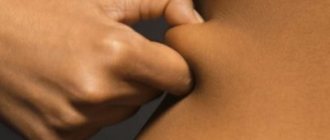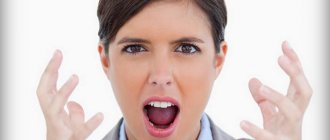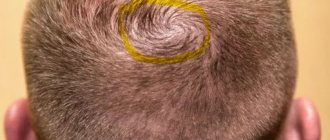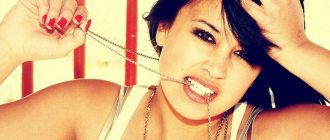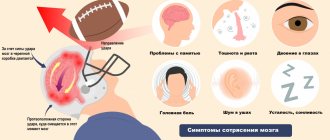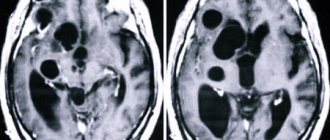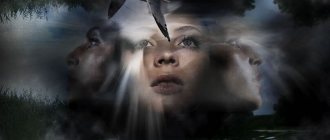Headache in one point when pressing. Cluster pain
A rare pathological condition that occurs predominantly in men and is characterized by painful headaches. The causes and mechanism of development of the disease are not fully understood. Patients note its sudden development; in rare cases, the attack begins with nasal congestion. The pain is localized in the parietal part of the head, radiating to the temple or eye area. There seems to be pressure on the skull from above, usually from one side. The sensations are sharp and burning, and can be boring. Accompanied by lacrimation, redness of the eyes, sweating of the face. Attacks last from 15 minutes to 1.5 hours and are repeated several times a day for 1-3 months.
You can learn more about cluster pain here.
A neurological disease of unknown etiology most often causes discomfort in women.
The headache appears from the top center and gradually covers one half of the skull. Symmetry of the symptom is rare. Sensations appear suddenly or after precursors - an aura. They are intense, similar to pulsation, radiate to the eye, temple or back of the head, and last from 2-3 hours to 3 days. Often the attack is accompanied by nausea and vomiting, which brings relief. The clinical picture intensifies under the influence of pungent odors, loud sounds, and bright light.
I. ENERGY POINT OF THE TOP OF THE HEAD
The ninth point is located on the top of the head above the middle part of the brain, called the crown point (Bai Hui, or GO-20) and corresponds to the location of the pineal gland. Its functions are related to sensitivity and the sexual cycle. The crown point controls the functioning of the heart, body rhythms, balance, perception of light by the eyes and skin, and is the main “partner” of the brain and spinal cord. In China, this point is called “connecting a hundred dots.” When the crown energy point is closed, we do not feel that we are in charge of our lives; we don't manage it and we behave recklessly. We are filled with illusions and pride, we experience chaotic mood swings and headaches. When the top of the head is open, we are controlled by higher powers. We radiate happiness, just as a blooming flower radiates its fragrance. We manage our own impressions and experiences. In the latter part of the highest Taoist practice, this point serves as a compass, leading the soul and spirit of a person to the place where they ultimately should be. If this point is fully developed, you will see a clear creative light giving direction and nourishment to your spiritual body. If you have reached this highest level of healing sexual energy, then very slightly pull up the front, middle and back parts of the anus and the chi muscles and bring the chi to the top of the head (Fig. 8-25). Help this movement by looking up with your eyes and concentrating your attention on this highest point. At first, you may feel pressure or a sort of expansion in the middle of your head. This is an indication that energy is arriving at a given point. Use the power of thought, eyes and all other senses to move the energy clockwise, making nine, eighteen, twenty-four or thirty-six revolutions, depending on how you feel. Once again we consider it necessary to emphasize the importance of the discovery of the Microcosmic orbit. If this orbit is open, you can easily bring healing sexual energy to the top of the head, and when the energy fills and overflows this area, it will begin to flow down to the point between the eyebrows where the pituitary gland is located. Taoists call this point the “primordial cavity of the spirit.” The energy point of the crown contains the main endocrine gland, the pineal gland, which controls the growth and function of the gonads, adrenal glands and thyroid gland.
K. THIRD EYE POINT
When the flow of sexual energy descends from the crown center to the third eye point, located between the eyes in the center of the forehead, it begins to radiate like the sun or opens like a flower. When this point is open, there is a sense of willpower, immediate and simple knowledge, intuitive wisdom and a sense of direction in life. A feeling of yourself appears. When positive energy accumulates and matures here, you smell and taste nectar flowing in a thin stream across your tongue, or see a beautiful blue pearl. When this point is closed, your mind seems to wander, indecisive, unreliable, and often irritable. Inside you there are endless dialogues of self-criticism and self-recrimination. When this center is closed, you feel that you have no direct knowledge and perception.
L. THROAT CENTER
From the third eye point the energy will continue to flow down into the nasal passages, the roof of the mouth, the tongue and the throat center. The throat center is located in the depression at the base of the throat above the top of the sternum. This place is in charge of the means of communication and exchange. When this center is open, we easily express ourselves on both verbal and non-verbal levels. This point has power over the word: what you talk about and what you ask for happens. The openness of this center contributes to the development of our speech: the sentences we use correspond to what we live. The openness of the throat center brings clarity of consciousness to our dreams, to the relationships between our souls and our other selves. When the center is closed, you may feel suffocated, you may feel guilty, you may have difficulty swallowing, as if there is a lump stuck in your throat. You may feel reluctant to change. Feel the energy pouring into your throat, as if this place is tanning in the sun. Throw out of your head all the memories associated with this feeling of closure in your throat. Feel the throat open and blooming with the power of speech. Become aware of the clarity in your dreams and the flexibility you have in your ability to express yourself. The energy continues to flow down to the heart center, located in the middle of the chest one inch from the lower end of the sternum. This heart center is a point of great importance for women's practice. It is a place of energy transformation and therefore the seat of feminine energy for healing and love. From the heart center, energy will flow down to the solar plexus and then to the navel.
M. UMBILICAL CENTER
When the navel center is open, we feel balanced, calm, and centered, allowing ourselves to be as we are and everything else to be as it is—without any effort. We experience complete awareness of everything. An open navel center allows us to be in a state of acceptance, to appreciate everything, and to feel abundance in everything. When this center is closed, there is a lack of balance and centeredness. The navel center is where excess energy is stored and is thus the repository for the energy that we have built up. If we continue to bring energy to the navel center, it will naturally Center and open. When you feel the energy collected in the navel, you will find that this place is the place of your original connection with your mother and the place where you received your nourishment when entering this world. Here we experience a natural abundance of everything. Try to practice holding the energy at one point at a time and move up sequentially, point by point. At first, you don't need to work on all the points at once. When you feel that all your partner's channels are open, you can choose the appropriate points to use each time. Make decisions according to your partner's needs, discuss hand positions with your partner in advance, letting each other know what you intend to do. Study this entire book together so that he can also understand what you are doing. Your mutual understanding and joint work on the practices described here will lead to harmony between you. Once you have completely opened your partner's spinal canal with your hands, you can use your hands to accelerate the flow of sexual energy.
Pressure pain in the back of the head. For hypotension
Low blood pressure is often not the cause of headaches, but can act as a catalyst for pathological processes that affect well-being.
Abnormal circulation caused by hypotension sometimes leads to excess blood in the vessels, arterioles and small arteries of the head. The vessels dilate and there is excess blood flow, which stretches them. During the stretching process, throbbing pain occurs.
When the back of the head hurts, increased intracranial pressure is diagnosed, causing discomfort. Hypotension is not often the root cause of pain in the back of the head or head. Even in a few clinical cases, pain from the back of the head is rarely observed; more often, hypotension leads to discomfort in the temples.
The onset of pain due to hypertension in a hypotensive patient is predominantly noted, when, with normal blood pressure for a healthy person (120–130/80 mm Hg), a hypotensive patient experiences pain and other symptoms of high blood pressure.
This type of pain occurs due to decreased tone of the veins located inside the skull.
Pain can be triggered or increased by:
- a prolonged state of leaning forward, especially when the head is below the level of the heart;
- increased physical stress on the neck and shoulder blade area;
- prolonged lying.
Changes in the functioning of the endocrine system
Systematic irritation with cold, to which the feng fu point is exposed, leads to an avalanche-like improvement in the functioning of the body. The level of resistance to external aggressive factors increases, and the immune system begins to work with amazing efficiency.
The endocrine system is stabilized, which affects many processes occurring in the human body. Diseases such as diabetes of various types, obesity, dystrophy, endocrine disorders of reproductive functions, malfunctions of the thyroid and pancreas glands can disappear without a trace.
People who have lived with such defects for many years have spent a lot of resources on research and treatment, having already lost hope of returning to a full life. They will be more than wary of the declaration that the key to getting rid of many years of suffering is located on their neck and this is just a feng fu point. Reviews from patients who have undergone special therapy, including cold treatment, say that this is possible. Moreover, cryodynamics with influence on a known point was carried out with a concomitant change in eating habits and lifestyle. This integrated approach allows you to get unprecedented results.
Headache in the forehead area. Diagnostics
Only a specialist can tell you exactly why your head hurts in the forehead area. Determining the cause is associated with an analysis of the nature of the pain and accompanying symptoms. Signs of a cold will be detected by a therapist or pediatrician by conducting a general examination and obtaining a blood test. This doctor will also suspect inflammation of various forms of sinusitis. However, only an otolaryngologist can make an accurate diagnosis based on an x-ray and blood test.
Most diseases that lead to pain in the head are diagnosed by a neurologist. To clarify the diagnosis, he prescribes the following studies:
- MRI. The resulting images make it possible to evaluate the structure of the brain, tissue density, the presence of tumors, necrosis, hematomas, the amount of cerebrospinal fluid, and the condition of blood vessels. Can be performed on young children and pregnant women. Children are performed under anesthesia.
- CT scan. As a result of the examination, a detailed picture is obtained that characterizes the presence of inflammation, tumors, and hemorrhages. Helps to see lesions of the sinuses, skull bones, and membranes of the brain.
- Angiography. It is a type of radiography with the introduction of a contrast agent.
- Ultrasound and Dopplerography of the brain and neck. Allows you to see organic lesions, identify disturbances in the shape, size of blood vessels, individual areas of the brain, and determine the speed of blood flow.
To confirm intracranial hypertension, consultation with an ophthalmologist is necessary. Also, in order to determine this diagnosis, a puncture of the cerebrospinal fluid is performed.
For whom cryodynamics is contraindicated?
The relationship between the feng fu point and body rejuvenation makes the procedure very popular. Despite the complete harmlessness of the method, its use is strictly contraindicated for certain categories of people. First of all, these are patients susceptible to epilepsy, schizophrenia and other mental disorders. For them, this method can provoke an exacerbation of the disease. It is not recommended to use feng fu activation for pregnant women. This can cause oxygen starvation of the fetus, which can lead to developmental complications.
Persons who use a pacemaker may also forget about feng fu. Impact on the point in their case can also provoke negative consequences.
All other people who have reached the age of 17 can successfully apply this method in practice. It is not necessary to be the owner of the ailments listed above. This procedure will be an excellent preventive measure for completely healthy people. The feng fu point and the rejuvenation of the body after exposure to it is a reality.
Headache in the back of the head. Features and types of pain
Doctors identify several features of pain in the occipital region:
1. Primary, which is not related to diseases and appears in 90% of cases.
2. Secondary, which appears as a result of inflammation and occurs in 10% of cases. In approximately 4% of patients who complain of a headache in the back of the head, serious illnesses are found that can become a threat not only to their general condition, but also to life.
Pain in the back of the head can appear in different directions and most often it occurs on the left.
As a rule, discomfort is observed during head movements, and some patients think that the symptom appears not in the head, but in the cervical region, after prolonged work in a sitting position or severe fatigue.
There are several types of pain in the back of the head on the left side:
1. Acute. It begins as a result of emotional tension, stress and depression.
2. Stupid. Unpleasant sensations appear, the person cannot touch the head. A similar condition is typical for osteochondrosis and arthritis.
3. Aching. The back of the head hurts due to spasm in the shoulders or neck. Often occurs during severe mental stress.
4. Pulsating. Pain in the back of the head with high blood pressure and symptoms often appear in the morning. In addition, white spots appear in the eyes and tinnitus.
Regardless of its appearance, an occipital headache on the left causes a lot of discomfort; a person cannot concentrate and work normally.
If symptoms appear regularly, then a high-quality and complete diagnosis is necessary.
Pain relief points - how to find them
Massage points to relieve headaches
To find points for pain relief, massage therapists use in their work so-called atlases - instructions for the location of points, which contain the centuries-old experience of Eastern healers. First of all, it is worth noting alternative Chinese medicine. It is on its basis that acupressure is being developed and successfully used today.
Points for relieving headaches are divided into groups. They are affected depending on which area of the head or neck the patient experiences discomfort or painful tension.
- A point in the recess that is located at the top of the auricle.
- Symmetrical points at the inner edges of the eyebrows.
- Symmetrical dots in the depressions near the outer edges of the eyebrows.
- The point above the bridge of the nose, in the area between the eyebrows (“third eye”).
- The point in the occipital region where the neck muscles connect.
- A point in the depression at the back of the head, located 1.5 cm above a line mentally drawn from the top edge of one ear to the other.
- The point in the temple area where the artery passes.
Stimulation of these points can reduce pain. Experts advise starting massage at the initial stage, and not at the moment when the pain reaches its peak.
Painful point on the head. Primary point pain
One of the types of point cephalgia is primary head pain, the symptoms of which in most cases are typical and rarely appear in another form:
- acute pain manifests itself in the form of single or serial impulses, similar to an injection;
- the duration of spontaneously occurring attacks does not exceed a few seconds, while the time interval between them varies from several times a day to a month;
- the location of outbreaks of pain is the area of the temples, crown, frontal lobes and orbits;
- attacks of primary pain are not aggravated by symptoms that appear in other types of cephalalgia.
The causes of primary point pain must be considered individually.
Such pain in most cases is not associated with serious diseases, but can occur under the influence of external factors - unfavorable weather conditions, drinking cold drinks, fatigue or stress on the organs of hearing and vision. People suffering from histamine cephalalgia or migraine are also susceptible to point primary headaches. In this case, sharp impulses appear in the area of localization of migraine and cluster pain. Primary pain, which occurs rarely and in isolated cases, does not require drug treatment, since it does not inhibit the functioning of the body as a whole and does not reduce the quality of life. If a headache occurs in one point more often than usual, the patient, in consultation with the doctor, can take the following medications:
Is something bothering you? Illness or life situation?
Describe your problem to us, or share your life experience in treating the disease, or ask for advice! Tell us about yourself right here on the site. Your problem will not go unnoticed, and your experience will help someone!
- Painkillers. In most cases, this is Indomethacin, the positive effect of which is experienced by up to 65% of patients susceptible to primary point pain. To protect the gastric mucosa, gastroprotective drugs must be taken along with Indomethacin.
- Anti-inflammatory drugs whose actions are similar to Ibuprofen.
- Neurohormonal agent Melatonin, which normalizes brain activity, activates mental processes, memory, and thinking. Melatonin is prescribed by a doctor if Indomethacin is ineffective, taking into account multiple contraindications (for example, pregnancy) and side effects (emotional swings, weakness, nausea, dizziness, drowsiness).
The effectiveness of head massage
Eliminate pain and discomfort with head massage
Head massage is an effective way to eliminate pain and discomfort. No one can argue with its effectiveness. On the contrary, neurologists are required to prescribe massage procedures, which, together with drug treatment, make it possible to cope with the disease. For allergy patients, going to a massage therapist is perhaps the only way to alleviate their condition. Massage is often prescribed for sick children for whom the use of strong anesthetics is contraindicated.
If the massage was carried out correctly, the effect will be noticeable after 4 sessions. The person will feel not only a dullness of pain, but also a surge of strength and energy. The body mobilizes its mental and physical abilities: long-forgotten vigor and tranquility appear, mood and memory improve.
My forehead hurts when I touch it. What to do if your forehead hurts and your temperature rises?
The most likely cause of pain in the forehead in combination with an increase in body temperature is an acute respiratory viral infection (influenza, parainfluenza). In addition, this symptomatology can also precede inflammation of the frontal paranasal sinuses (frontal sinusitis). It is worth noting, however, that in addition to the above reasons, these symptoms can also occur with many other pathologies. Treatment for each of these pathologies may differ significantly, and that is why it is important to consult a doctor in a timely manner to correctly diagnose the disease. In order to relieve pain, nonsteroidal anti-inflammatory drugs (NSAIDs), which have a moderate analgesic effect, are usually used. To reduce the severity of headaches, the following medications are most often used:
- paracetamol;
- aspirin;
- diclofenac;
- ibuprofen;
- naproxen.
Also, these medications can lower body temperature to a certain extent (eliminate fever and chills). This is achieved due to the fact that these medications are able to influence the thermoregulation center and increase the normal body temperature to a higher point. It is worth noting that children can be given only two drugs to reduce body temperature - paracetamol and ibuprofen. Unlike other representatives of this drug group (NSAIDs), these two drugs have virtually no side effects and are therefore relatively safe.
Painful point on the left rib. Pain in the ribs
Rib pain usually refers to discomfort that occurs in the chest wall, rather than inside it. In this case, the source of discomfort is bone or cartilage tissue, adjacent muscles or nerves. Pain in the ribs can be of a different nature: it can be constant or intermittent, sudden or increasing, acute or dull. Doctors explain this diversity by a large number of underlying causes.
Pain in ribs when pressed
Sometimes an inflammatory process can occur in the cartilages that are attached to the sternum - Tietze syndrome. Pain in the ribs when pressed in this case can be quite intense and resemble symptoms of angina pectoris. In addition, attacks can occur spontaneously, without external influence. The localization of pain can be very diverse.
Tietze's disease is accompanied by additional symptoms:
- swelling in the area of the inflamed costal cartilage;
- when pressing or squeezing the sternum, the discomfort becomes stronger;
- the first attack may develop against the background of trauma.
In any case, if discomfort in the rib area bothers you for more than three days, you should definitely seek help from a doctor. But before you go to your appointment, you can undergo a self-diagnosis on our website. It contains a simple test, by answering the questions of which you can get a preliminary diagnosis and understand which specialist you need to make an appointment with.
Painful point on the foot. 21 points on the feet, massage of which improves well-being
- On our feet there are projection zones of many internal organs, by acting on which we can improve our well-being.
- It is recommended to massage the feet as a whole, rather than individual points. First, your feet need to be stretched and warmed up: walk barefoot, rise on your toes several times, take a warm foot bath.
- Rub the entire foot with stroking movements, then begin to press on each active point (3-7 seconds), moving from the toes to the heel. Also use techniques such as pulling (when massaging your fingers), tapping (with the edge of your palm), pinching, and kneading.
- In the process, you may discover pain points. This means that the organs for which they are responsible are not in order. These points need to be massaged with special care.
- The technique of influencing painful areas is pressure (with the thumb), which must be alternated with pauses, and the whole process should take at least a minute. The result of a properly performed massage is the disappearance of pain.
- The following contraindications exist for foot massage: high temperature, impaired blood clotting, exacerbation of chronic diseases, deep scratches or injuries on the surface of the feet.
Bright Side will show you the most important points and tell you how to massage them to always feel 100%.
Painful point on the abdomen. Pain points in the head and neck area
- pain points of exit of the I, II, III branches of the trigeminal nerve - with neuralgia of this nerve, sinusitis, meningism and meningitis, arachnoiditis (absent in comas);
- Greenstein's vascular pain points: at the inner corner of the orbit - with phlebitis and thrombophlebitis of the facial veins; behind the ears in the area of the tubercles of the occipital bone - with vasomotor pathologies of cerebral vessels, meningitis;
- pain points in the temple area above the zygomatic process - with arteritis and sympathalgia of the face, leptomeningitis;
- pain points in the area of the mastoid process, in front and downward from the tragus of the ear - with neuritis and neuralgia of the facial nerve, otitis, mastoiditis;
- pain points at the base of the skull above the first cervical vertebra at the exit point of the occipital nerves - with neuralgia of these nerves, cervical osteochondrosis, meningitis, tumors of the cerebellopontine zone;
- pain points of the spinous processes of the cervical vertebrae, intervertebral discs, paravertebral - for osteochondrosis, herniated intervertebral discs;
- pain points of the vertebral artery on the line connecting the apexes of the mastoid process and the spinous process of the second cervical vertebra - with pathology of the vertebral artery and cardialgia of various origins.
Biologically active points on the face and head
In the previous article about massage, I mentioned biologically active points located on the face and head. Let's look at them in more detail
When massaging your face, you can pay more attention to those points that are responsible for the organs and systems that require attention. Also, when massaging your face with hot bags, you can warm up these areas, activating biologically active points on the face. Thus, facial massage will become not only a cosmetic, but also a therapeutic procedure.
Let's consider each point separately.
- 3M Located on the mid-anterior line of the head. Impact on this point treats the stomach, trachea, as well as the “pons,” located in the brain stem and responsible for supplying the brain with oxygen . Acupressure of this point eliminates dizziness .
- 10B A bony prominence that extends from temple to temple, through the center of the frontal bone and then rises upward to a distance of about 5 cm above the temporal bone. This five centimeter area represents an important area. This is a psychosomatic zone, used in the treatment of eyes with blurred vision .
- 18 is located between points 10B , in the very center of the forehead. A very important point responsible for the function of the pituitary gland . Severe pain at this point indicates a disorder in the pituitary gland, which is one of the most important endocrine glands. If there is a violation at this point, it is necessary to simultaneously influence point 21, which is located on the spinous process of the 7th cervical vertebra, at the junction of the neck and shoulders and controls the pituitary gland, thyroid gland and the entire skeletal system of the body. Impact on point 21 relieves pain and is used for heart disorders, disorders of the spinal and spinal nerves.
- 14M is located in the center, between the eyebrows, at the root of the nose. Impact on this point can eliminate some problems associated with blurred vision, stomach dysfunction, and pain in the lower legs.
- 6 paired point, located on the anterior edge of the supraorbital bone on both sides of the root of the nose (at the beginning of the eyebrow). Treats all sinuses, in particular the maxillary sinus, as well as brain diseases. Prolongs life, improves immunity.
- 92 paired point, located in a small notch on the outer lower edge of the orbital bone. Used for mental disorders, heals the eyes.
- 34 paired point, located directly above the middle of the eyebrows on the frontal bone. Impact on this point heals the eyes, intestines, relieves intoxication of the body due to food poisoning, has a therapeutic effect on the frontal lobes of the brain, controls consciousness, and provides energy to the body . If you feel sleepy while driving, vigorously press this point for a few seconds and you will feel a surge of energy and the drowsiness will go away.
- 10M paired point located on the supraorbital notch under the eyebrows. Pressure on this point has a healing effect for diseases of the frontal parts of the brain, liver, gall bladder, pleurisy and neuralgia of the sciatic nerve. Eliminates pain in the lower back and legs.
- 17 Paired point located on both sides of the bridge of the nose. Eliminates excessive eye strain and fatigue (one of the most common causes of headaches), heals the stomach . Using the pads of your thumbs, slide under the eyebrows to this point and press upward. Any painful area in this area should be treated with your thumbs.
- 13M zone, located in the middle of the nose, at the border where the bone ends and the cartilage begins. It has a connection with the occipital lobe of the brain ; by eliminating disturbances in this part of the brain, pneumonia . When treating duodenal ulcer, it is necessary to act on this point daily until improvement occurs.
- 16M is located under the center of the nose. Associated with the anterior lobe of the pituitary gland , used in the treatment of certain types of paralysis . Impact on this point eliminates sneezing .
- 9B is a paired point located at the upper end of the zygomatic bone, in front of the upper edge of the ear. Impact on this point normalizes the functions of the large intestine and kidneys .
- 12M paired point, located below point 9B next to the loop-shaped fascia of the cheekbone in front of the middle part of the ear. Treats muscles , including the heart muscle , the entire venous system (including the lungs and eyes), ear pathology, as well as heart valves. The point is useful for certain types of headaches .
- 4 paired point, located approximately 5 cm 12M disorders of the brain and spinal nerves .
- 16B is a paired point located below the outer corners of the lips on both sides of the chin, in the center of the lower jaw bone, on the mandibular foramen. Associated with the posterior lobe of the pituitary gland , used for endocrine disorders and the treatment of the common cold.
- E is located in relieves high blood pressure. For high blood pressure, apply pressure directly into the ear, then lightly upward towards the nose. In this case, sensations arise throughout the body and in the lower extremities.
- 11B paired point located on the back of the cheekbones (see diagram). Pain when pressing on this point indicates the presence of foci of infection in the head or other parts of the body.
- 3B paired point, located at the lower edge of both cheekbones. It has a therapeutic effect for inflammation of the sinuses, sinuses, in particular the frontal sinus, and treats the mucous membranes.
- 11M Paired point located at the intersection of the cheekbone and nose. Used in the treatment of allergies, diseases of the lungs and bronchi, inflammation of the maxillary sinuses and nasal congestion. With the index fingers of both hands, press firmly inward and upward on the area adjacent to both sides of the nose. With upward pressure, a small part of the bone is felt - this is the paired point 11M.
- 52 paired point, located in the very center of the temple, in the place where it feels like a small hole into the brain. Check if this point is painful, even if the pain is not exactly in the center of the point, massage this area until the pain disappears. This will give a therapeutic effect for diseases of the abdominal organs, lungs, and eyes . Acupressure in this area helps remove excess fluid from the body and is effective for ascites .
- 53 if you place your fingers behind the ear, you will find a small bone called the mastoid process of the temporal bone - mastoid. To influence this area, you need to press it twice from below, and then a little from the side. This will have a therapeutic effect on the functioning of the intestines, colon and hearing organs.
- 19 (feng chi) massage of this point helps improve the flow of blood and qi, relieve mental and nervous tension . The Feng Chi point is located under the occipital bone, approximately 2.5 cm above the posterior border of hair growth in the fossa at the outer edge of the trapezius muscle, where a depression is palpated. This point is affected by headaches, eye diseases, lacrimation, dizziness, decreased hearing, high blood pressure, neurasthenia and emotional imbalance. A short massage of this point has a general tonic effect. This point belongs to the points that “restore life” and must be influenced extremely carefully.
- 63 paired point, located at the end of the styloid bone - it is affected by pressure under the ear. An effective point for amnesia, improves memory, improves brain function.
- JB8 is located under the lower jaw and is a groove in the bone that can be felt by running a finger towards the back. This point is affected for headaches and toothaches .
- JB10 is located at the back of the mandible. In all cases of glaucoma, in case of poisoning, as well as people wearing glasses with bifocal lenses, it is recommended to place your index finger on the back of the jaw (see diagram) under the ear and apply pressure forward, and you should feel pain at this point. This point controls the level of intraocular pressure. Pressing on this point gives a feeling of warmth behind the eyes, as blood circulation in this area is normalized. If this makes you feel nauseous. Stop exposure for a while, then continue exposure after normalization.
- JB9 is located on the curve of the jaw between points JB8 and JB10 and affects all parts of the intestine.
- 51 paired points on the masticatory muscles of the lower jaw. The point has an effect on the facial muscles, eyes, and eliminates premature wrinkles . Acupressure of this point has a therapeutic effect in case of mumps , and also prevents possible complications of reproductive function, especially in boys.
- 14B is located in the middle of the back of the skull. in the region of the posterior inferior occipital convexity. It affects the medulla oblongata, with which this point is closely connected, and treats paralysis . Helps with all stomach disorders and flatulence .
- 80 paired point, located under the base of the skull, on the back of the neck, on both sides of the center (see diagram). Impact on this point treats headaches , some types of eye diseases , as well as nosebleeds . Treats the spleen . Note: Frequent nosebleeds indicate a disease of the spleen.
- 5B The area where this point is located is located along the lateral muscles of the neck at the transverse processes of the cervical vertebrae. The impact on this area should be gentle and careful. This is a general somatic point, used for diseases of the abdominal organs and intestinal dysfunction.
- 48 is located on the back of the neck, in the region of the 3rd cervical vertebra and controls the thoracic lymphatic duct . The thoracic duct is the main artery of all lymphatic vessels of the body, located on the left side. It transports most of the lymph and chyle (milky juice) into the blood. Impact on this point balances the energy balance in the thoracic duct; in case of all lymph circulation disorders, it is necessary to control this point and act on it first.
- 15B is located at the upper edge of the chest, shaped like a cup. When exposed to a certain side part of it, one or another part of the throat and brain . A very important area for treating the throat, esophagus, abdominal organs, and prolapse of organs (kidneys, uterus).
- 12B paired point, located on both sides of the base of the neck, on the anterolateral wall of the sternocleidomastoid muscle, at the point of its intersection with the clavicle. The left point is responsible for the left side of the body, relieves pain in the heart and left arm during angina pectoris . The right point is responsible for the right side of the body.
- 15M paired point, located on the upper edge of both clavicles (see diagram) and regulates metabolism in the body.
- 13B paired point, located near the thyroid gland and directly affects it. Thyroid dysfunction can cause palpitations, weight loss, and in case of insufficient function, excess weight. The thyroid gland also controls body temperature.
These points can be pressed regularly, or they can be reflected using special herbal patches or Thai balms.
I have been using knowledge about biologically active points on the body for more than one year. Often, knowledge about these points helped me and the people around me. There was a case when on the train in our compartment, my grandmother, who was traveling with us, had a heart attack. My knowledge of these points saved her life and saved us from an unpleasant situation.
The photo shows an example of treating influenza by applying herbal patches to the points. This photo is more than 6 years old, this is my brother, who came home from school with a temperature of over 40. I accidentally found this photo in a folder with old photographs. There were still patches on his body on his arms, in the area responsible for temperature and on his legs. Within 2 hours the temperature dropped to 37, and by morning he was practically healthy.
Now I have the opportunity to share this knowledge with you. Use it for your health.
If the article arouses interest, I will continue this topic with articles about points on the feet and other parts of the body.
Share on social media networks
Similar articles:
The Secret of Thai Happiness
Moringa: properties and use - internally and externally
The Seventh Principle of Buddhist Healing: Food as Medicine
